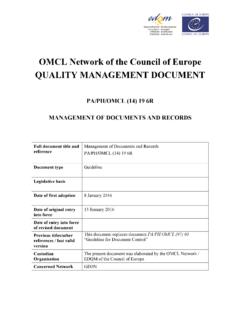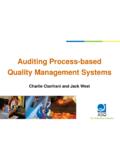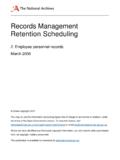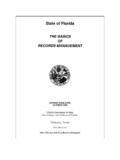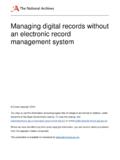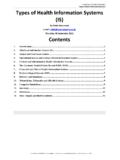Transcription of chapter 49 Pharmaceutical management …
1 chapter 49 pharmaceutical management information systemsSummary Importance of a Pharmaceutical management information system of a Pharmaceutical management information system Functions of a Pharmaceutical management information system Data and information The information systems Meeting the information needs of users with different requirements Typical components of a Pharmaceutical management information system documents Data compilation/aggregation tools Data-reporting forms Feedback Steps in designing or revising a Pharmaceutical management information system Key issues in designing or revising a Pharmaceutical management information system Implementing a Pharmaceutical management information system From information to action data Presenting information Interpreting information Taking actionReferences and further readings guide 49-1 The information systems pyramid 49-2 Flow of documents in a basic supply system PMIS 49-3 PMIS information stages 49-4 Graph styles 49-1 information users and information needs 49-2 Forms and records for a basic supply system PMIS 49-3 Proposed PMIS indicators for building a
2 Pharmaceutical supply system in Namibia: rational use of medicines and quality of care 49-4 Improving recording and reporting accuracy 49-1 Steps in designing or revising a PMIS 49-2 Job description for a Pharmaceutical management information officer in Kenya 49-3 Example of information interpretation and use studiesCS 49-1 Using the Electronic Dispensing Tool to manage Pharmaceutical information at different levels of the health care system 49-2 Building a data management information system for MDR-TB surveillance in Brazil 49-1 Sample annual EMP status report I: Policy and economic issuesPart II: Pharmaceutical managementPart III: management support systemsPlanning and administrationOrganization and managementInformation management48 Monitoring and evaluation49 Pharmaceutical management information systems50 Computers in Pharmaceutical managementHuman resources managementcopyright management sciences for health information Importance of a Pharmaceutical management information systemA good PMIS provides the necessary information to make sound decisions in the Pharmaceutical sector.
3 Effective Pharmaceutical management requires policy makers, pro-gram managers, and health care providers to monitor information related to patient adherence, drug resistance, availability of medicines and laboratory supplies, patient safety, postmarket intelligence, product registration, prod-uct quality, financing and program management , among other the elements of a Pharmaceutical supply system requires relevant, accurate, and timely informa-tion. Increased funding for HIV/AIDS, tuberculosis, and malaria programs has contributed to the need for accu-rate and timely information on a variety of parameters that affect the ability to conduct accurate quantification, procurement planning, budgeting, resource mobilization, and program management .
4 In addition, multiple donors require different data reports, complicating program man-agement. Because a Pharmaceutical supply system uses many forms and other documents, managers often feel as if they are buried under mountains of data and that filling in the forms and producing reports ends their responsibility. They are unable to analyze and use many of these data for improved decision making. Many factors affect the usability of these data, including data quality and quantity (for example, missing or incomplete data or too much data to analyze effectively) or a manager s lack of analytical skill.
5 Therefore, many managers find them-selves making decisions based not on information but on chapter focuses on the practical aspects of organiz-ing and managing a routine Pharmaceutical management information system . It should be read in conjunction with Chapters 48 and 50. chapter 48 puts information manage-ment into the broader context of monitoring and evaluating program performance against long-term goals and objec-tives and against medium-term workplans and targets. chapter 50 presents a variety of tools for analyzing data pro-duced by the of a Pharmaceutical management information systemThe PMIS integrates Pharmaceutical data collection and the processing and presentation of information that helps staff at all levels of a country s health system make evidence-based decisions to manage Pharmaceutical planning process for a new or revised pharmaceu-tical supply system should include a Pharmaceutical management information system (PMIS).
6 The PMIS is an organized system for collecting, processing, reporting, and using information for decision making. information for each subsystem is collected by means of Record-keeping documents, a combination of regis-ters, ledgers, and filing systems that typically are not circulated information reporting forms, such as periodic status reports, that transmit data to other departments or levels for use in making management decisions Feedback reports, also called analytical reports, that are usually provided to the units that collected the dataDesign or revision of a PMIS should be based on the differing information needs of users at each level of the system and should build on existing forms, reports, and procedures as much as possible.
7 Any forms should be designed through a participatory process and field-tested with staff who will use issues to consider include Selection of indicators to monitor system perfor-mance and intended results (discussed in chapter 48) Integration of the PMIS with other data collection systems Computerization at appropriate levelsA successful PMIS requires effective use of the infor-mation generated, which includes Efficient data processing to reduce large amounts of data to a manageable number of key indicators, often in summary tables Presentation of information in graphic form to sim-plify interpretation Interpretation of information to identify trends and potential problems Appropriate use of technology (for example, e-mail, websites)
8 To present and share information with a wider audience in less time Action in response to both positive and negative results Effective mechanisms to provide and receive feed-backsuMMary 49 / Pharmaceutical management information systems features that distinguish a PMIS from a logistics man-agement information system include The incorporation of patient-specific data in addition to product-centered data A focus on decision making for Pharmaceutical ser-vices, not just resupply information on outcomes related to medicine use, such as adherence, adverse drug reactions, and pharmaco vigilance, that affect Pharmaceutical policy and selection decisions, including individualized treat-ment options overarching information about the Pharmaceutical sector, such as a summary of available professionals/personnel, outlets, legislation status, and distribution of personnel and facilities Varied data sources from the whole Pharmaceutical sector.
9 Not just activities related to procurement and inventory management The ability to triangulate consumption data with clini-cal and patient-specific dataFunctions of a Pharmaceutical management information systemAn effective PMIS is able to synthesize the large volume of data generated by Pharmaceutical management operations. It then processes the data into information for use in plan-ning activities, estimating demand, allocating resources, and monitoring and evaluating Pharmaceutical management operations. This information is often in the form of a few key indicators. Indicators should be targeted toward staff at all levels so that they can monitor both their own performance and that of the units for which they are can t use the dataThose who collect data never see the resultsThe data are so badbecauseReturn for HeadquartersFeedback Reports from HeadquartersEMP HeadquartersIncoming ReportsTHE BAD DATA information MANAGEMENTA nother important function of a PMIS is to improve accountability.
10 Much of the recording and reporting in a PMIS is intended to create an audit trail for products as they enter or leave a Pharmaceutical supply and informationAn understanding of the distinction between data and information is necessary to appreciate how a management information system functions. Data represent real-world observations or measurements. Data, in and of themselves, often have little value and take on meaning only after they are processed into a more usable form. information is a meaningful aggregation of data that can be interpreted for a specific use. In other words, information is processed data that contains sufficient context to make it meaningful.










